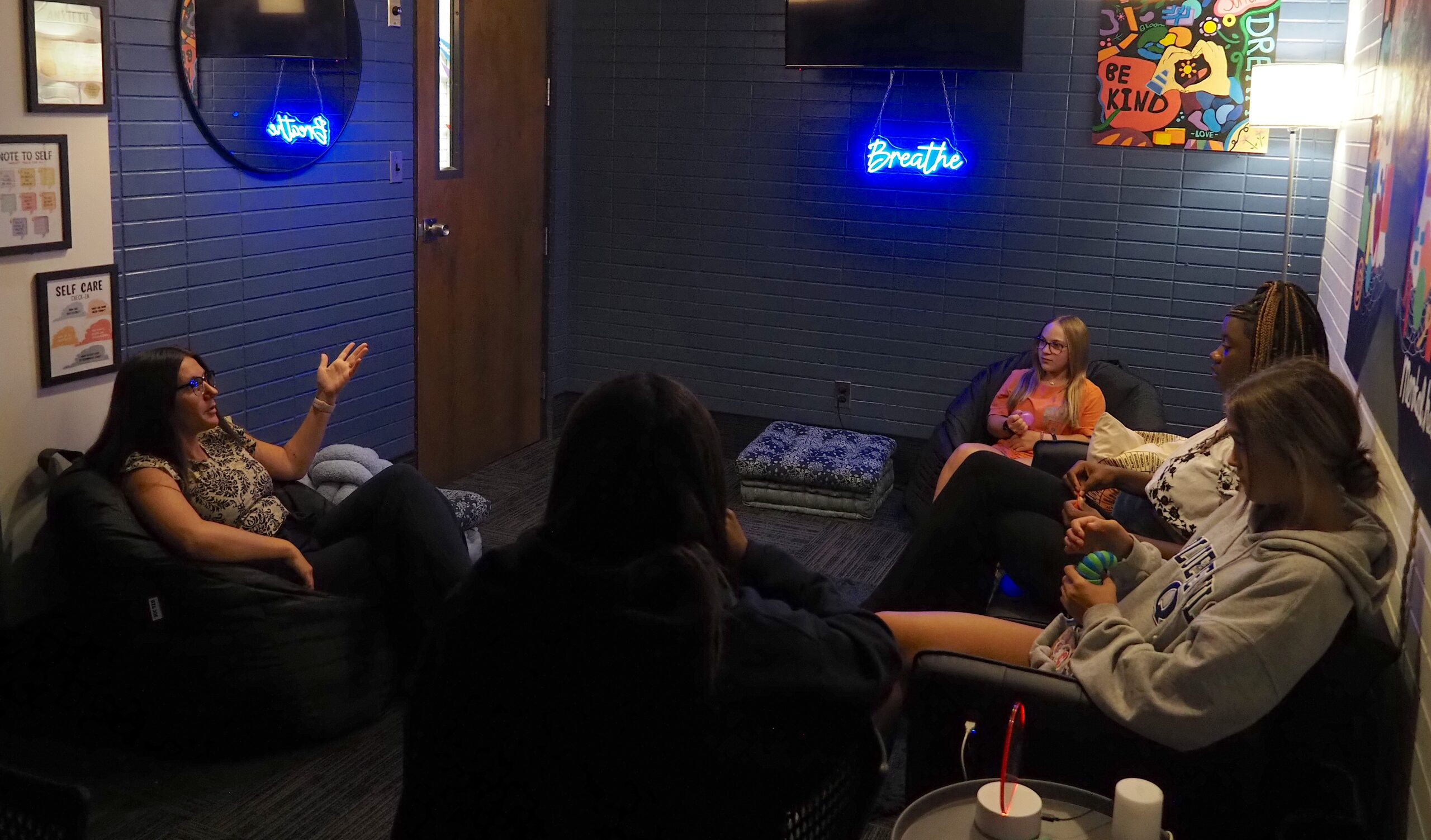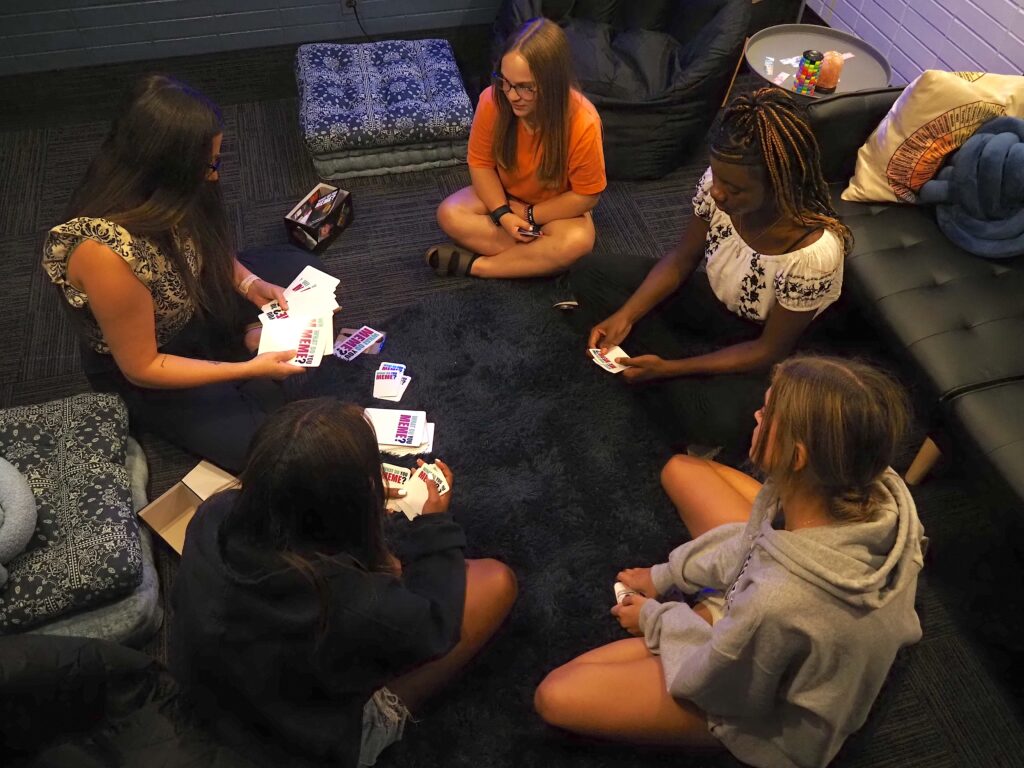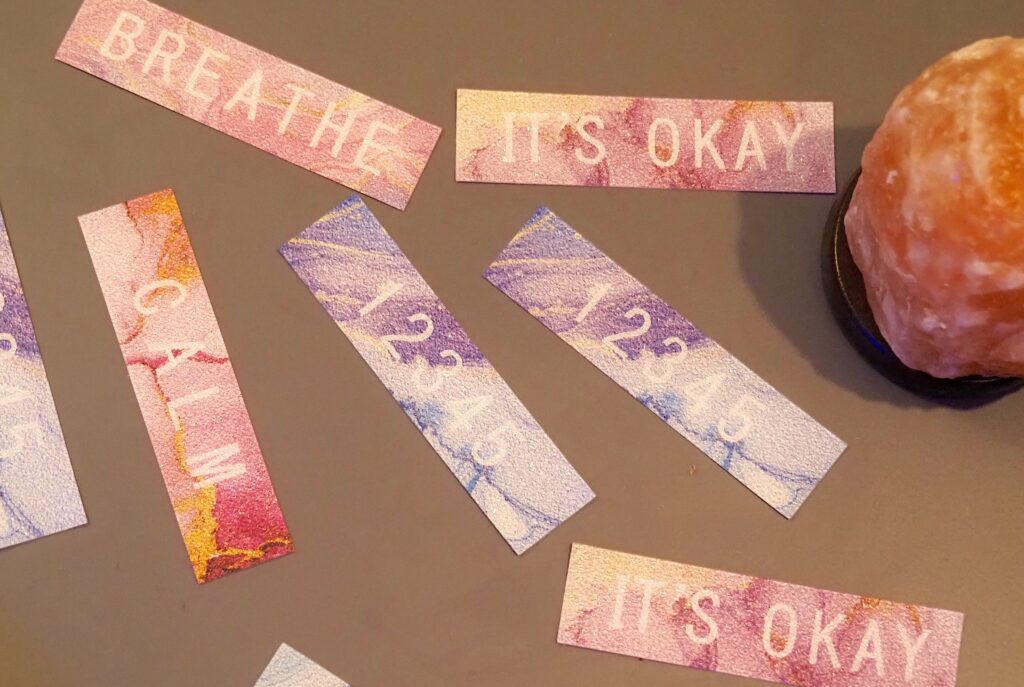QHS counseling department introduces Regulation Station to help students with mental health, academics

“There’s too many people.”
“I can’t handle it.”
“I need a smaller space to work.”
The Quincy High School counseling department heard all of those comments from their students, similar to when adults in office settings feel the itch to “get out of the office” in moments of frustration or overwhelm.
A special room was created in response.
The Blue Devil Regulation Station, formerly a cluttered catch-all conference room, now provides a cozy and confidential nook for students, teachers, counselors and staff to escape when they need a break from the feelings that weigh them down and hold them back.
The goal is to “improve academics, decrease referrals and improve mental health” by providing a quiet and private space that can turn “I can’t handle this” moments — which often end in students leaving school — into “I no longer feel like I need to leave, I think I just needed a break” moments.
Katie McCaughey, a junior at QHS, is one of several students who have already benefited from the room.
“I feel comfortable in here,” she said. “I feel like myself in here … I can get my work done.”

Little break, big impact
On the surface, QHS students are getting a cool room with bean bags and low lights to hang out in when they feel like they’re drowning in schoolwork, drama with friends or any trials and tribulations that come with being a teenager in a post-pandemic world, a polarized culture and an increasingly plugged-in generation.
But it’s easy to see the domino effect on a deeper level that a room such as this can have on a student’s overall performance.
“There are so many studies that show that mental health is directly correlated with attendance issues, and attendance is also correlated with academic issues,” Camille Donaldson, a QHS counselor, said.
In addition to the benefits of taking general breaks throughout the school day at lunch, gym class and recess, a quick break in an overwhelming moment allows students to slow down and regulate their emotions. They can continue with their day instead of tossing it altogether and going home because of one bad interaction or being forced to remain in a distracting, anxiety-inducing environment.
“Instead of hiding in the bathroom or maybe leaving school — because we do have students who do that because they just ‘can’t handle it’ — our goal is to keep them here,” Ashley VanCamp, another QHS counselor, said.
“Mental Health and Attendance At School,” a 2022 book edited by Katie Finning, Tamsin Ford and Darren A. Moore, says the links between mental and behavioral disorders and school attendance are plentiful.
Depressive disorders often result in symptoms of fatigue and loss of motivation, which can lead to school absences. Severe social anxiety disorders are in constant conflict with the social nature of academic environments, which can lead to school absences. Defiant behavioral disorders are, by definition, more attracted to truancy, which can lead to school absences. Aggressive behavioral disorders result in a lack of acceptance among peers, which can — you guessed it — lead to school absences.
Symptoms of disorders are then exacerbated by several issues that arise in the short term from excessive absences, like “reduced connectedness and academic achievement,” which then leads to more absences, and the cycle continues.
How important is attendance? Extremely. The book says low attendance rates are “associated with impaired socio-emotional development and (are) predictive of school dropout, which predicts unemployment and lower life expectancy.”
The latest CDC report, released in August, indicates mental health rates among teenagers have improved since 2021, but rates are still far from where they were a decade ago, especially for teenage girls. Fifty-three percent of high-school-aged girls reported “persistent feelings of sadness or hopelessness” in 2023 — down from 57 percent in 2021 but higher than the 39 percent of girls who reported similar feelings in 2013.
Changes in the percentage of high school boys who reported these feelings mimicked the girls’ course but with less severity. The figure jumped from 21 percent in 2013 to 29 percent in 2021, then down to 28 percent in 2023.
The pandemic’s unprecedented isolation and uncertainty for the future undoubtedly affected these rates. But considering the uptick began years before, around 2017-18, some saw the writing on the wall long before the days of school closures and mask mandates.
“It was coming, whether the pandemic was there or not,” Chad Struck, another QHS counselor, said. “I think it just sped the problem up … Whether it was social media, cell phones, family dynamics.”

Little room, big dream
Before becoming the cozy corner of campus, the former conference room was cluttered with boxes and used as a conference room for staff meetings and occasional meetings with parents. The project started in January. Finishing touches were added last week.
The room’s transformation was sponsored by the Dream Big Foundation, a fundraising campaign spearheaded by the Quincy Public Schools Foundation. The organization amassed more than $350,000 in donations during last year’s fundraising campaign. The foundation approved 22 grants last month — totaling nearly $150,000 — that will be used during the 2024-2025 school year.
The counseling department utilized the money the foundation allocated to buy plush rugs and pillows, ambient lighting, various decor items and window clings. The space has a much-needed sense of privacy without compromising on a sense of openness. Dozens of fidget toys and games can give students something to focus on as they take mental breaks.
Funds also were used to buy paint supplies for five paintings, created by students, centered around the theme of mental health.
Getting student feedback and encouraging them to contribute was an intentional and essential aspect of the room’s remodel.
“(Students) get to take pride in saying, ‘I helped create this, and this was created for me with me in mind,’” VanCamp said. “We wanted to create a space that was welcoming for all students. Any chance that we could give them a say, we wanted to give them a say.”
Sisters Ellie and Ashtyan Fesler worked during the summer on one of the paintings — an unidentifiable yet comfortingly familiar character who watches over the space’s guests from the confines of the canvas she was painted on. Spirals, squiggles, stars and social media-esque hearts swarm around her head with brightly colored boxes faintly reminiscent of Piet Mondrian floating in the spaces on wiry strands of hair.
“It is gorgeous,” VanCamp said. “(It) totally exemplifies mental health and everything that it means, and what happens in our minds when we’re feeling overwhelmed and anxious.”
They don’t plan on pursuing art after high school, but both Ellie and Ashtyan find the hobby beneficial to their mental health.
“It kind of calms me down because I’m just moving with my hands a lot,” Ellie, a sophomore, said.
“Art is an amazing outlet for me, especially (because) I have really bad anxiety,” Ashtyan, a senior, said. “Art is the best distraction … I think it’s great for your mental health.”
The Fesler sisters are two of the many helpers who brought the room to life.
“It was 100 percent the vision of the counselors — based on the needs of our students — the art department and the maintenance staff,” VanCamp said. “They were very helpful. They were incredible.”
Whether students want to be distracted by coloring or playing games, or if they prefer to lay on the couch in silence and observe the art in the room, the Regulation Station is ready to help them manage.
Miss Clipping Out Stories to Save for Later?
Click the Purchase Story button below to order a print of this story. We will print it for you on matte photo paper to keep forever.

